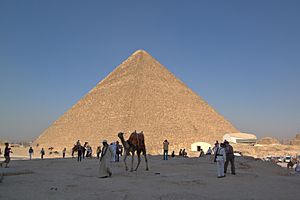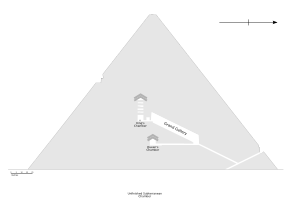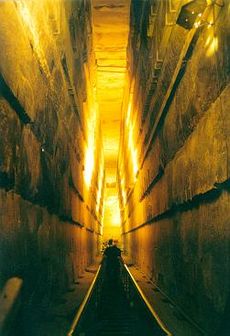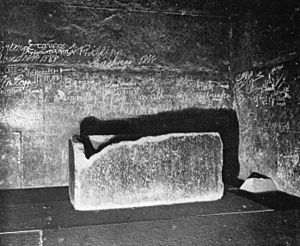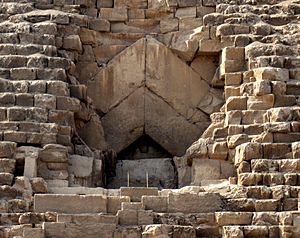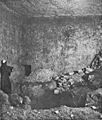Great Pyramid of Giza facts for kids
The Great Pyramid of Giza is a giant pyramid built by the Ancient Egyptians. It stands close to Cairo, Egypt. It is the oldest of the Seven Wonders of the Ancient World, and it's the only one that is still mostly complete. When it was built, it was 146.5 meters (481 feet) tall. It was the tallest building in the world for more than 3,800 years!
The pyramid was built for Khufu, an Egyptian pharaoh (king). Some people believe Khufu's helper, Hemiunu, was the main builder. It probably took about 20 years to build and was finished around 2570 BC.
When it was new, the Great Pyramid was covered with smooth, shiny stones on the outside. You can still see some of these stones near the bottom. Most of what we see today is the main part, made of 2,300,000 blocks of limestone and granite.
People have many ideas about how the pyramid was built. Most ideas suggest that huge stones were moved from a quarry (a place where stones are dug up). Then, they were dragged and lifted into place. Scientists found that the Great Pyramids of Giza were not built by slaves. Instead, they were built by workers who were paid for their hard work. Their graves were found near the pyramid in 1990.
There are three known rooms, or chambers, inside the Great Pyramid. The lowest room is carved into the rock under the pyramid. This room was never finished. The other two rooms are higher up inside the pyramid. They are called the Queen's Chamber and the King's Chamber. We don't know what the Egyptians really called them or how they planned to use them. The Great Pyramid is special because it has two passages, one going up and one going down. It's the only Egyptian pyramid with both.
The Great Pyramid is part of a group of buildings called the Giza Necropolis. This group includes two mortuary temples (temples for the dead) built to honor Khufu. One is near the pyramid, and one is close to the Nile River. There are also three smaller pyramids for Khufu's wives. Other buildings include an even smaller "satellite" pyramid and a raised path called a causeway that connects the two temples. There are also other tombs, called mastabas, likely for other important people.
Contents
History of the Great Pyramid
Experts who study ancient Egypt, called Egyptologists, believe the pyramid was built as a tomb for Pharaoh Khufu (also known as "Cheops"). It took about 20 years to build. Khufu's main helper, Hemiunu, is thought by some to be the architect, or main designer, of the Great Pyramid. The pyramid weighs about 5.9 million tonnes (that's 5.9 billion kilograms!). Its total size is about 2.5 million cubic meters.
If it took 20 years to build, this means workers had to put about 800 tonnes of stone in place every single day!

The Great Pyramid was the tallest man-made structure in the world for over 3,800 years. No other building was taller until the spire of Lincoln Cathedral was finished around 1300 AD. The pyramid was built with amazing accuracy. The four sides of its base are almost perfectly equal in length, with only a small difference of about 58 millimeters. The sides are also lined up very closely with the four main compass directions (north, south, east, west).
Building Materials
The Great Pyramid is made of about 2.3 million stone blocks. Most people think these blocks were brought from nearby quarries (places where stone is dug up). The white limestone used for the outside covering came from quarries across the Nile River. The biggest granite stones, found in the "King's" chamber, weigh between 25 and 80 tonnes. These heavy stones were brought all the way from Aswan, which is more than 800 kilometers (500 miles) away!
Ancient Egyptians traditionally cut stone blocks by hammering wooden wedges into them. Then, they would soak the wedges with water. As the wood soaked up the water, it would expand and cause the rock to crack. Once the stones were cut, they were carried by boat along the Nile River to the pyramid site. It's estimated that 5.5 million tonnes of limestone, 8,000 tonnes of granite, and 500,000 tonnes of mortar (a type of cement) were used to build the Great Pyramid.
Outer Casing Stones

When it was finished, the Great Pyramid was covered with smooth, white "casing stones." These stones were made of highly polished white limestone. They were cut very carefully to fit together perfectly.
Today, you mostly see the stepped core structure of the pyramid. In 1303 AD, a huge earthquake shook the area. This earthquake loosened many of the outer casing stones. Later, in 1356, a ruler named An-Nasir Nasir-ad-Din al-Hasan took many of these stones away. He used them to build mosques and forts in nearby Cairo. More casing stones were removed in the early 1800s by Muhammad Ali Pasha to build his Alabaster Mosque in Cairo. You can still see these limestone pieces in those buildings today.
Old explorers reported seeing huge piles of broken stones at the base of the pyramids. These were from the casing stones that had fallen off. These piles were later cleared away during excavations.
A few of the original casing stones can still be seen today around the very bottom of the Great Pyramid. They show the amazing skill and precision of the ancient builders.
How it was Built
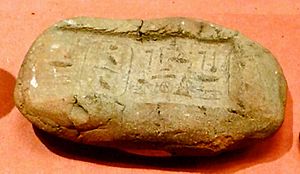
Many ideas have been suggested about how the pyramid was built. People disagree on whether the blocks were dragged, lifted, or even rolled into place. The Greeks thought that slaves built the pyramid. However, recent discoveries at nearby worker camps suggest that tens of thousands of skilled workers built it instead.
Egyptologists believe that about 14,500 people worked on the project on average. At its busiest times, there might have been around 40,000 workers. These workers did not use pulleys, wheels, or iron tools. Experts think the Great Pyramid was completed in about 10 years.
Inside the Pyramid
The original entrance to the Great Pyramid is on the north side. It is 17 meters (56 feet) above the ground. From this entrance, a passage goes down at a steep angle. This passage is about 0.96 meters (3.1 feet) high and 1.04 meters (3.4 feet) wide. It goes through the pyramid's stone and then into the rock underneath.
After about 105 meters (345 feet), the passage becomes flat. It continues for another 8.84 meters (29 feet) to the lowest room, which seems unfinished. Some Egyptologists think this lowest room was meant to be the first burial chamber. But perhaps Pharaoh Khufu changed his mind and wanted his tomb higher up.
About 28.2 meters (92.5 feet) from the entrance, there's a square hole in the ceiling of the downward passage. This hole, which was once hidden, is the start of the upward passage. This upward passage is 39.3 meters (129 feet) long and goes up at almost the same angle. It leads to the Grand Gallery.
The lower end of the upward passage is blocked by three huge granite stones. Each stone is about 1.5 meters (5 feet) long. Today, visitors use a "Robbers' Tunnel" to get past these blocks and into the upward passage. At the start of the Grand Gallery, there's a hole in the wall. This is the beginning of a vertical shaft that goes down through the pyramid to connect with the lower passage. Also at the start of the Grand Gallery, there is a horizontal passage that leads to the "Queen's Chamber." This passage is 1.1 meters (3.6 feet) high for most of its length.
Queen's Chamber
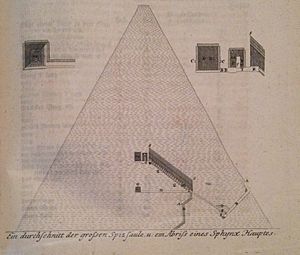
The "Queen's Chamber" is exactly in the middle of the pyramid, between its north and south sides. At the eastern end of the room, there is a niche (a small alcove) that is 4.67 meters (15.3 feet) high. The niche was originally 1.04 meters (3.4 feet) deep, but treasure hunters made it deeper.
In the north and south walls of the Queen's Chamber, there are narrow shafts. Unlike the shafts in the King's Chamber, these go horizontally for about 2 meters (6.6 feet) before sloping upwards. Their purpose is not known. At the end of one of these shafts, a black diorite (a type of rock) ball and a bronze tool were found. These objects are now in the British Museum.
In 1993, a German engineer named Rudolf Gantenbrink used a robot called Upuaut 2 to explore the shafts in the Queen's Chamber. After climbing about 65 meters (213 feet), he found that one shaft was blocked by limestone "doors" with two copper "handles." Years later, the National Geographic Society used a similar robot. In 2002, this robot drilled a small hole in the southern door, only to find another door behind it! The northern passage was also blocked by a door.
Research continued in 2011 with the Djedi Project. They used a special "micro snake camera" that could see around corners. This allowed them to look through the hole drilled in 2002 and see inside the small room behind the first door. They found hieroglyphs (ancient Egyptian writing) painted in red. They also looked closely at the copper "handles" on the door and now think they were just for decoration. They also saw that the back of the "door" was smooth and polished. This suggests it wasn't just put there to block the shaft, but for a more important reason.
Grand Gallery
The Grand Gallery continues the upward slope of the Ascending Passage. At its bottom, it is 2.06 meters (6.8 feet) wide. But as it goes up, the stone blocks in the walls lean inwards. This happens seven times, making the top of the Grand Gallery only 1.04 meters (3.4 feet) wide. The roof is made of stone slabs placed at a slightly steeper angle than the floor. Each stone fits into a slot, like the teeth of a ratchet. This design helped support each block from the wall, rather than having it rest on the block below, which prevented too much pressure.
At the top of the Grand Gallery, on the right side, there's a hole near the roof. This hole leads to a short tunnel that gives access to the lowest of the Relieving Chambers. The other Relieving Chambers were found in 1837–1838 by Colonel Howard Vyse and J. S. Perring. They dug tunnels upwards using blasting powder.
The floor of the Grand Gallery has a raised shelf or step on both sides, each 51 centimeters (20 inches) wide. This leaves a lower ramp 1.04 meters (3.4 feet) wide in the middle. In these shelves, there are 54 slots, 27 on each side. The purpose of these slots is not known. However, the central gutter in the floor, which is the same width as the Ascending Passage, has led some to think that blocking stones were stored in the Grand Gallery. The slots might have held wooden beams to stop them from sliding down the passage.
At the very top of the Grand Gallery, there is a step that leads to a horizontal passage. This passage is about 1.02 meters (3.3 feet) high and wide. It has four slots, and three of them were likely meant to hold granite portcullises (heavy gates that drop down).
In 2017, scientists from the Scan Pyramids Project found a large empty space above the Grand Gallery. They used a special technique called muon radiography that can detect cosmic rays. This space is at least 30 meters (98 feet) long and is similar in shape to the Grand Gallery. Its purpose is not known, and it cannot be reached. Some experts, like Zahi Hawass, think it might have been a gap used during the construction of the Grand Gallery. However, a Japanese research team disagrees, saying the huge void is different from other construction spaces found before.
King's Chamber
The "King's Chamber" is about 10.47 meters (34.4 feet) from east to west and 5.234 meters (17.2 feet) from north to south. It has a flat roof that is 5.852 meters (19 feet 2 inches) above the floor. About 0.91 meters (3 feet) above the floor, there are two narrow shafts in the north and south walls. One of these shafts now has a fan to help air move inside the pyramid.
The purpose of these shafts is not clear. They seem to point towards certain stars or areas of the sky. However, one of them has a bend, which means it wasn't meant for directly looking at stars. For a long time, Egyptologists thought they were "air shafts" for ventilation. But now, many believe the shafts had a ritual purpose, helping the king's spirit go up to the heavens.
The King's Chamber is completely covered with granite. Above the roof, which is made of nine heavy stone slabs weighing about 400 tons, there are five empty spaces called Relieving Chambers. The first four, like the King's Chamber, have flat roofs. But the very top chamber has a pointed roof. These spaces were meant to protect the King's Chamber from the huge weight of the stone above it, preventing the roof from collapsing. Since these chambers were not meant to be seen, they were not finished or decorated. Some stones still have marks painted on them by the builders.
The only object in the King's Chamber is a rectangular granite sarcophagus (a stone coffin). One corner of it is broken. The sarcophagus is a bit larger than the Ascending Passage. This means it must have been placed in the Chamber before the roof was put on. Unlike the smooth walls of the Chamber, the sarcophagus is roughly finished, with saw marks visible. This is different from the beautifully finished sarcophagi found in other pyramids from the same time.
Images for kids
-
The Greek historian Herodotus was one of the first important writers to talk about the Great Pyramid.
-
During the Roman Empire, Pliny the Elder suggested that "bridges" were used to move stones to the top of the Great Pyramid.
-
The Relieving Chambers above the King's Chamber, drawn by Charles Piazzi Smyth in 1877.
See also
 In Spanish: Gran Pirámide de Guiza para niños
In Spanish: Gran Pirámide de Guiza para niños


